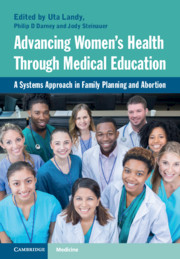 Advancing Women's Health Through Medical Education
Advancing Women's Health Through Medical Education from Section III - Family Planning Curricular Design & Implementation
Published online by Cambridge University Press: 30 July 2021
This chapter describes the several important roles for simulation in sexual and reproductive healthcare training. First and foremost, simulation training can serve as a tool for basic skill acquisition to learn abortion, contraception, and sterilization procedures.Simulation can also provide opportunities for improving counseling and communication, and emergency response team training. Finally, simulation training can foster an environment for discussion, advocacy, and sparking interest in the field of sexual and reproductive health.Many low- and high-fidelity simulation tools have been developed, implemented, and evaluated for training purposes.The chapter details the many available family planning simulation models and evidence supporting their utility.
To save this book to your Kindle, first ensure no-reply@cambridge.org is added to your Approved Personal Document E-mail List under your Personal Document Settings on the Manage Your Content and Devices page of your Amazon account. Then enter the ‘name’ part of your Kindle email address below. Find out more about saving to your Kindle.
Note you can select to save to either the @free.kindle.com or @kindle.com variations. ‘@free.kindle.com’ emails are free but can only be saved to your device when it is connected to wi-fi. ‘@kindle.com’ emails can be delivered even when you are not connected to wi-fi, but note that service fees apply.
Find out more about the Kindle Personal Document Service.
To save content items to your account, please confirm that you agree to abide by our usage policies. If this is the first time you use this feature, you will be asked to authorise Cambridge Core to connect with your account. Find out more about saving content to Dropbox.
To save content items to your account, please confirm that you agree to abide by our usage policies. If this is the first time you use this feature, you will be asked to authorise Cambridge Core to connect with your account. Find out more about saving content to Google Drive.